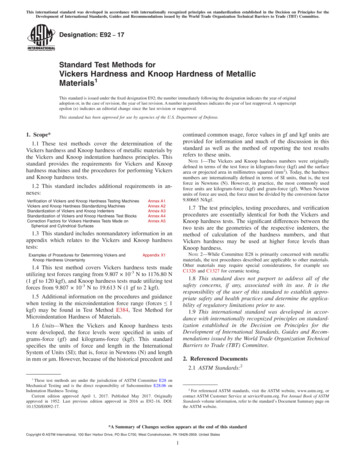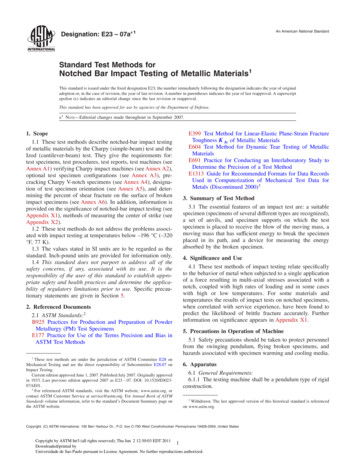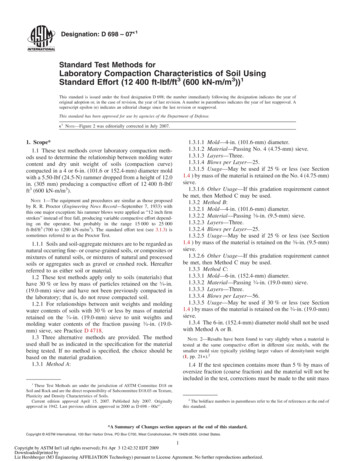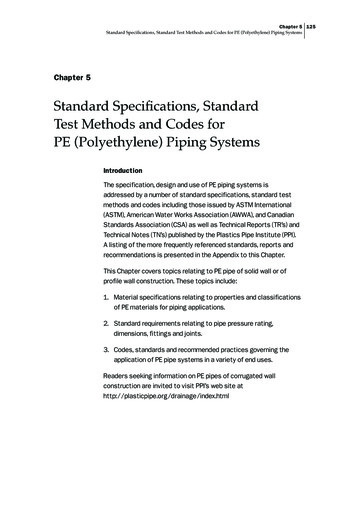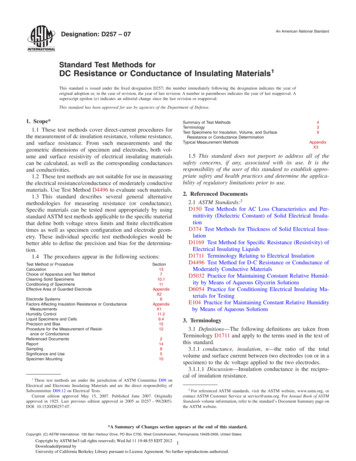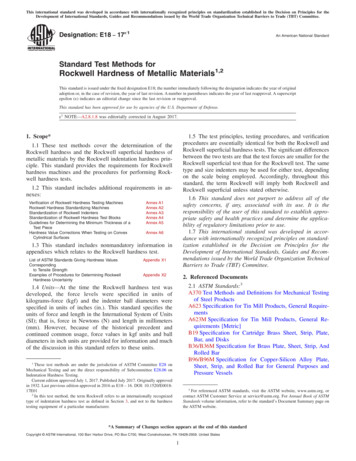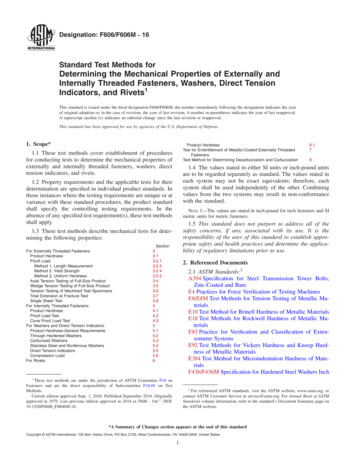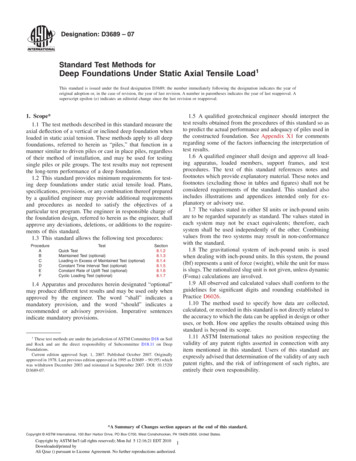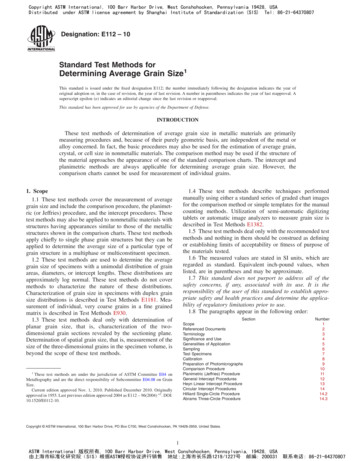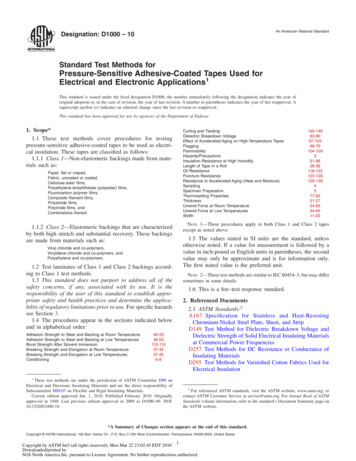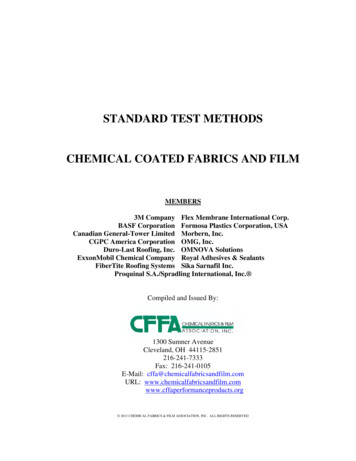
Transcription
STANDARD TEST METHODSCHEMICAL COATED FABRICS AND FILMMEMBERS3M Company Flex Membrane International Corp.BASF Corporation Formosa Plastics Corporation, USACanadian General-Tower Limited Morbern, Inc.CGPC America Corporation OMG, Inc.Duro-Last Roofing, Inc. OMNOVA SolutionsExxonMobil Chemical Company Royal Adhesives & SealantsFiberTite Roofing Systems Sika Sarnafil Inc.Proquinal S.A./Spradling International, Inc. Compiled and Issued By:1300 Sumner AvenueCleveland, OH 44115-2851216-241-7333Fax: 216-241-0105E-Mail: cffa@chemicalfabricsandfilm.comURL: roducts.org 2013 CHEMICAL FABRICS & FILM ASSOCIATION, INC. ALL RIGHTS RESERVED
2FOR BETTER PRODUCTS . . .America’s leading manufacturers and consumers - use products from ChemicalFabrics and Film members for a myriad of uses.AIRCRAFTSeat backs, upholstery, wall panels and compartments.ATHLETICS & SPORTINGGOODSBowling bags, exercise mats, golf bags, gym and workout bags, tennisbags.AUTOMOTIVE &TRANSPORTATIONCamper topping, convertible topping, door and console coverings,instrument panel coverings, landau tops, security shades, upholstery.EXTERIOR FILMS &LAMINATESAwnings and canopies, backlit awnings and signage, banners, outdoordecking, outdoor furniture, pond and pit liners, roofing, swimmingpool liners, tents and tarpaulins.FOOTWEAR & GARMENTSBelts, jackets, protective clothing, rainwear, shoe uppers, sock linings.GRAPHIC ARTS & CASECOVERINGSBookbinding coverstock, checkbooks, coin purses, etc., hand bags andaccessories, luggage and briefcases.HOME & CONTRACTFURNISHINGSCeiling tile facings, commercial seating, commercial wallcoverings,folding doors, laminating films for wood, metal and wallboard, matting,residential upholstery, residential wallcovering, window shades andblinds.MARINEConvertible topping, decking, upholstery and bolsters.MISCELLANEOUSChildren safety seats, industrial tapes, juvenile furniture, mattresscovers, strip doors, tank lining, toys.
3FOREWORDThis, the Ninth Edition of the Standard Test Methods (STM) Pamphlet, has been prepared by the TechnicalCommittee of the Chemical Fabrics & Film Association. These test methods are used by the industry and itscustomers to determine the physical properties of chemical coated fabrics and films, to facilitate quality control andto ensure customer satisfaction.Section I covers test procedures for coated fabrics; Section II covers test procedures for films. These tests includeadhesion of coating, weight, resistance to cold, blocking, aging, abrasion resistance, hydrolytic stability, volatility,tensile, tearing strength, and many more. The purpose of each test is explained in non-technical terms, and the testsare referenced to comparable standard test methods of the American Society for Testing and Materials, Federal TestMethods, Specifications, and the American Association of Textile Chemists and Colorists.Section III includes terminology and customs in the Industry. Also in this section are suggestions on how to removecommon stains. Additional information in Section III includes a statement on fitness for use, the chronologicalhistory of fabric coating and information about the Chemical Fabrics & Film Association.Every effort has been made to ensure the accuracy of the information in this Pamphlet and the avoidance ofexcessive risks in the tests. However, the Association and those responsible for the preparation of Associationpublications make no representation or warranty, or assume or accept any responsibility or liability, with respectthereto.In test methods where a specific material, apparatus, and/or supplier is listed, please note that such a listing is for theconvenience of users of the Standard Test Methods. Any equipment from any supplier which produces comparableresults under the testing procedure is acceptable.
4TABLE OF CONTENTSSubjectSection I---Tests for Chemical Coated FabricsStandard Conditions of Test .CFFA-1Abrasion Resistance .a.Wyzenbeek Methodb.Taber Abraser MethodCFFA-2Accelerated Light Aging .a.Fadeometerb.Weatherometerc.QUV Accelerated WeatheringCFFA-3Adhesion of Coating to Fabric .CFFA-300Bacterial Resistance .CFFA-4Blocking .CFFA-5Button Pull-Through Resistance .CFFA-6Cold Crack Resistance .a.Roller Methodb.Mandrel MethodCFFA-7Crocking Resistance .a.Dryb.WetCFFA-700Dimensions of Coated Fabric .a.Widthb.Lengthc.Thicknessd.MassCFFA-8Dry Cleanability .CFFA-9Flame and Smoke Resistance .CFFA-10Flex Resistance .CFFA-11Hydrolytic Stability - Vinyl .CFFA-110Hydrolytic Stability - Polyurethane .CFFA-12Lacquer or Varnish Lifting.CFFA-120Mildew Resistance .CFFA-121Pink Stain .CFFA-13Oil Resistance .CFFA-130Scrubbability .CFFA-14Seam Strength .CFFA-140Shrinkage .CFFA-141Stain Resistance .CFFA-15Stretch and Set .CFFA-16Tearing Strength .a.Elmendorf Methodb.Tongue Methodc.Trapezoid MethodCFFA-17Tensile Strength and Elongation - Grab Method .CFFA-18Volatility .CFFA-180Washability .CFFA-19Water Vapor Transmission .CFFA-20Weight of Coating and Fabric 12223242627282829
5Section II -- Tests for Chemical FilmsAbrasion Resistance .a.Wyzenbeek Methodb.Taber Abraser MethodBlocking .Density .Dimensional Changes at Elevated Temperatures .Dimensions of Film .a.Widthb.Lengthc.Thicknessd.MassLayflat .Low Temperature Impact Resistance .Permeability to Air .PVC Roll Contour and Racetracking .Snap Back Testing for Pool Liner Films .Soapy Water Extraction .Tearing Strength .a.Graves Methodb.Elmendorf MethodTensile Properties of Thin Plastic Sheeting .Volatility .3637Section IIITerminology and Customs in the Industry .Cleaning and Care Instructions .Fitness for Use .Information About the Products and the Chemical Fabrics & Film Association FFA-27CFFA-27030303031323233Deleted33343435Note: Test methods are listed alphabetically. Single and double digit numbers used to reference the testmethods contained herein have not been changed from the previous editions. Three-digit numbersindicate test methods added to the Seventh and later Editions.
6SECTION ITests for Chemical Coated FabricsSTANDARD CONDITIONS OF TESTReference: ASTM D751-06(2011) - Standard Test Methods for Coated FabricsPhysical tests may be made under prevailing atmospheric conditions except in the settlement of disputes. Unlessotherwise specified, tests shall then be made upon material in standard conditions, i.e., the condition reached whenthe material is in moisture equilibrium with an atmosphere having a relative humidity of 65% and temperature of70 F (21 C). A tolerance of /- 2% is permitted in relative humidity and /- 2 F (1 C) in temperature. Materialshall be considered to be in equilibrium when it shows no progressive change in weight after free exposure tomoving air.Because of the labor involved in determining whether equilibrium has been reached, it is customary to condition thematerial for a minimum period of 15 hours at the temperature and relative humidity previously mentioned.Note: These conditions are standard and will be used unless the test method requires special environmentalconditioning.(Rev. 3/13)CFFA - 1 ABRASION RESISTANCEa.Wyzenbeek MethodPurpose:To determine the abrasion resistance of chemical coated fabrics under service conditionsReference:ASTM D4157-10 - Standard Test Method for Abrasion Resistance of Textile Fabrics(Oscillatory Cylinder Method)Apparatus:Oscillatory Cylinder Type*To determine abrasion resistance of chemical coated fabrics, one specimen of each sample approximately 2 x 8inches (5 x 20 cm) in size shall be cut with the long dimension parallel to the machine direction and tested forresistance to abrasion, using the Wyzenbeek abrasion wear tester, operating under the following conditions:Pressure on Specimen2 lbs.Tension on Specimen (with scalebar in horizontal position)6 lbs.Abradent#10 Cotton Duck (certified to meet the requirements of ASTMD4157-10)**#220 Grit Silicon Carbide Sheet,Stainless Steel Screen (Surface Screen 50 x 70 Mesh,Support Screen 14-18 Mesh) or Abradents as specifiedSpeed, Double Rubs/Hour5000Temperature of Room70 - 90 F (21 - 32 C)On stretchable fabrics such as knit, masking tape shall be used to reinforce backing to prevent elongation.*Available from Schap Specialty Machine, Inc., 17309 Taft Street, Spring Lake, MI 49456,www.schapmachine.com or www.wyzenbeek.com.**Available from Testfabrics, P. O. Box 26, 415 Delaware Avenue, West Pittston, PA 18643, www.testfabrics.com.(Rev. 3/12)
7b.Taber Abraser MethodPurpose:To determine the abrasion resistance of chemical coated fabrics and filmsusing a rotary platform double head testerReference:ASTM D3389-10 - Standard Test Method for Coated Fabrics Abrasion Resistance (RotaryPlatform Abrader)Apparatus:Rotary Platform Double Head Abraser*To determine the abrasion resistance of a chemical coated fabric or film, one specimen of each sample shall be cutin a 4-1/8" circle and mounted on a S-16 Specimen Plate*. This specimen plate shall then be mounted on the Taberplatform. Abrasion resistance is tested by the Taber platform turning on a vertical axis, against the sliding rotationof two rubber-base abrading wheels. Various hardness abrasive wheels, test weights, and test cycles can be used inthe Taber test. These are specified depending on the type of material beingtested and the expected service requirements of the finished coated fabrics or film.After exposing the specimen to the required number of test cycles using the specified abrasive wheel and weight, thesample should be examined for signs of visual wear or loss of embossing detail.*Available from Taber Industries, 455 Bryant Street, North Tonawanda, NY 14120, www.taberindustries.com.(Rev. 1/12)CFFA - 2 ACCELERATED LIGHT AGINGPlastic materials that are used for both interior and exterior applications are subject to attack typically by ultravioletlight, oxygen and water. No single light exposure apparatus can exactly simulate natural exposure, as climaticconditions will vary with respect to geography and topography.Listed are commonly use
ASTM G151 and ASTM G155. Utilize water for humidity as specified in ASTM G151. 2. Carbon Arc . References: AATCC Test Method 16.2-2014 - Colorfastness to Light: Carbon-Arc, Option 1 . ASTM G153-13 Standard Practice for Operating Enclosed Carbon Arc Light . Apparatus for Exposure of Nonmetallic Materials – Cycle 2 . Apparatus: Carbon Arc Test Chamber*
